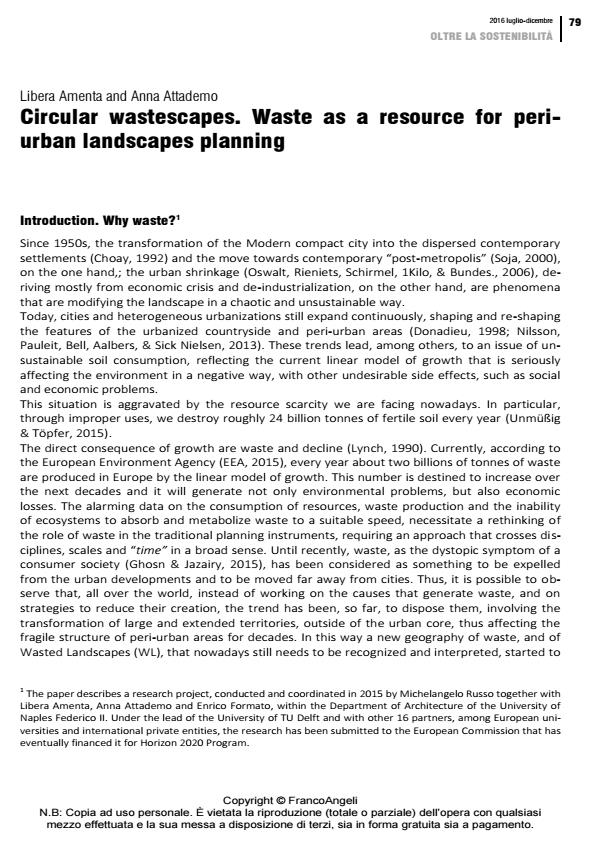Circular wastescapes. Waste as a resource for periurban landscapes planning
Titolo Rivista CRIOS
Autori/Curatori Libera Amenta, Anna Attademo
Anno di pubblicazione 2016 Fascicolo 2016/12
Lingua Inglese Numero pagine 10 P. 79-88 Dimensione file 1701 KB
DOI 10.3280/CRIOS2016-012008
Il DOI è il codice a barre della proprietà intellettuale: per saperne di più
clicca qui
Qui sotto puoi vedere in anteprima la prima pagina di questo articolo.
Se questo articolo ti interessa, lo puoi acquistare (e scaricare in formato pdf) seguendo le facili indicazioni per acquistare il download credit. Acquista Download Credits per scaricare questo Articolo in formato PDF

FrancoAngeli è membro della Publishers International Linking Association, Inc (PILA)associazione indipendente e non profit per facilitare (attraverso i servizi tecnologici implementati da CrossRef.org) l’accesso degli studiosi ai contenuti digitali nelle pubblicazioni professionali e scientifiche
The alarming data on the consumption of resources, waste production and the inability of ecosystems to absorb and metabolize them, necessitate a rethinking of the role of waste in traditional planning instruments. The research work adopts Circular Metabolism as a model, proposes to revert the perspective on waste management, towards Circular Economies to preserve the life of ecosystems, adding value at the local level. In this sense, the Living Labs seem to be an innovative instrument for urban planning, which is capable of merging the skills of researchers and policy makers together with the involvement of local communities.
- Beyond Wastescapes: Towards Circular Landscapes. Addressing the Spatial Dimension of Circularity through the Regeneration of Wastescapes Libera Amenta, Arjan Van Timmeren, in Sustainability /2018 pp.4740
DOI: 10.3390/su10124740 - No.Wall:S. Un progetto di rigenerazione, per l'ospitalità e la condivisione Enrico Formato, Anna Attademo, in TERRITORIO 82/2017 pp.129
DOI: 10.3280/TR2017-082023 - Integrated Approaches for Peri-Urban Wastescapes Francesca Garzilli, Chiara Mazzarella, Valentina Vittiglio, in International Journal of Urban Planning and Smart Cities /2020 pp.43
DOI: 10.4018/IJUPSC.2020070104 - Regenerative Territories Chiara Mazzarella, Libera Amenta, pp.71 (ISBN:978-3-030-78535-2)
- Six recommendations for a circular city. Pushing the sustainable urban transition forward Libera Amenta, in Planning Practice & Research /2025 pp.1
DOI: 10.1080/02697459.2025.2469421 - Regenerative Territories Anna Attademo, Gilda Berruti, pp.233 (ISBN:978-3-030-78535-2)
- WASTE AND WASTED LANDSCAPES: FOCUS ON ABANDONED INDUSTRIAL AREAS Silvia Iodice, Pasquale De Toro, in Detritus /2020 pp.103
DOI: 10.31025/2611-4135/2020.13975 - Regenerative Territories Pasquale De Toro, Silvia Iodice, pp.213 (ISBN:978-3-030-78535-2)
- Regenerative Territories Maria Somma, pp.297 (ISBN:978-3-030-78535-2)
- Latenze del paesaggio periurbano: in dialogo con François Jullien Francesca Garzilli, in CRIOS 19/2021 pp.34
DOI: 10.3280/CRIOS2020-019004 - Innovation in Urban and Regional Planning Maria Somma, pp.171 (ISBN:978-3-030-68823-3)
- Enhancing the Sustainability of Social Housing Policies through the Social Impact Approach: Innovative Perspectives form a “Paris Affordable Housing Challenge” Project in France Cristina Coscia, Subhash Mukerjee, Bianca Ludovica Palmieri, Chiara Quintanal Rivacoba, in Sustainability /2020 pp.9903
DOI: 10.3390/su12239903 - Managing the Transition towards Circular Metabolism: Living Labs as a Co-Creation Approach Libera Amenta, Anna Attademo, Hilde Remøy, Gilda Berruti, Maria Cerreta, Enrico Formato, Maria Federica Palestino, Michelangelo Russo, in Urban Planning /2019 pp.5
DOI: 10.17645/up.v4i3.2170
Libera Amenta, Anna Attademo, Circular wastescapes. Waste as a resource for periurban landscapes planning in "CRIOS" 12/2016, pp 79-88, DOI: 10.3280/CRIOS2016-012008